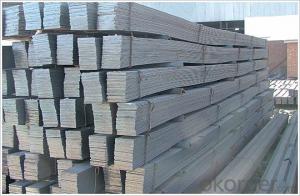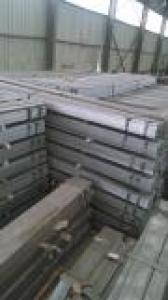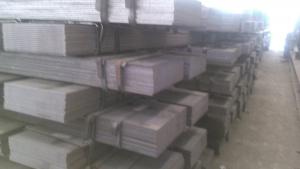FLAT BAR 20-200 HIGH QUALITY
- Loading Port:
- China Main Port
- Payment Terms:
- TT OR LC
- Min Order Qty:
- -
- Supply Capability:
- -
OKorder Service Pledge
OKorder Financial Service
You Might Also Like
Flat bar Details:
| Minimum Order Quantity: | | Unit: | m.t. | Loading Port: | |
| Supply Ability: | 10000 | Payment Terms: | | Package: | Steel Packing |
Product Description:
Product Description:
Specification of Mild Steel Flat Bar
Commodity: Mild Steel Flat Bar
Standard: GB;JIS
Material: Q195-235;SS400
Brand name: FLATSPACE
Origin place: China
Thickness: 3mm-30mm
Width:20mm-200mm
Length: Max 12m
Certification: SGS/BV
Chemical composition of Q235
Alloy No | Grade | Element(%) | ||||
C
| Mn
| S
| P
| Si
| ||
Q235
|
B
|
0.12—0.20 |
0.3—0.7 |
≤0.045 |
≤0.045
|
≤0.3
|
Physical properties of Q235
Alloy No | Grade | Yielding strength point(Mpa) | Tensile strength (Mpa) | Elongation after fracture(%) | ||||||
Thickness (mm) | Thickness (mm) | |||||||||
≤16 | >16--40 | >40--60 | >60--100 |
| ≤16 | >16--40 | >40--60 | >60--100 | ||
≥ | ≥ | |||||||||
Q235 |
B |
235 |
225 |
215 |
205 |
375--500 |
26 |
25 |
24 |
23 |
Usage/Applications of Mild Steel Flat Bar
Widely used for construction, Machinery manufacturing, Iron tower steel structure, Shipbuilding; Steel grating, Staircase, Bridge, Viaduct, Railway spare parts, Boilers making etc.
Packaging & Delivery of Mild Steel Flat Bar
Packaging Details: The Mild Steel Flat Bars are packed in bundles and loaded in 20 feet/40 feet container, or shipped by bulk cargo ,also we can do as customer's requirements.
Delivery Details:30~45 days upon the receipt of buyer payment by T.T. or L/C.
Production Flow of Mild Steel Flat Bar
The Mild steel flat bar is made through three processes:
1.Feeding the material: Feeding the row material (the steel plate) to Slitting Line.
2.Slitting:The steel plate would be slitted into expected width by lengthways cutter.
3. Leveled and cutting: The plat bar would be ground into level by the grinder and then cut into required length
- Q:What are the typical tolerances for steel flat bars?
- The typical tolerances for steel flat bars vary depending on the specific size and application. However, common tolerances for width range from +/- 0.005 to 0.030 inches, while thickness tolerances can be between +/- 0.005 and 0.015 inches. Length tolerances typically fall within +/- 0.125 to 0.250 inches. It is important to consult the manufacturer or industry standards for precise tolerances based on your specific requirements.
- Q:Can steel flat bars be used for fencing or security purposes?
- Yes, steel flat bars can be used for fencing or security purposes. They are durable, sturdy, and can provide a strong barrier for protection.
- Q:What is the load-bearing capacity of a steel flat bar?
- The load-bearing capacity of a steel flat bar depends on various factors such as the dimensions of the bar, the type and grade of steel used, and the specific application or use case. Generally, steel flat bars are known for their high strength and load-bearing capabilities. To determine the load-bearing capacity of a steel flat bar, engineers consider several factors including the thickness, width, and length of the bar, as well as the type of load it will be subjected to (such as static or dynamic loads). Additionally, the type of steel used and its mechanical properties, such as yield strength and tensile strength, play a significant role in determining the load-bearing capacity. To provide a more specific answer, it would be necessary to know the exact dimensions and properties of the steel flat bar in question, as well as the intended use and load requirements. Consulting engineering specifications, structural analysis, or professional advice would be necessary to determine the precise load-bearing capacity for a particular steel flat bar in a specific application.
- Q:Are steel flat bars used in structural engineering?
- Yes, steel flat bars are commonly used in structural engineering. They are versatile and widely used for various applications such as beams, columns, braces, and connections in buildings, bridges, and other structures. Steel flat bars offer excellent strength and durability, making them an essential component in structural engineering projects.
- Q:Can steel flat bars be used for fencing?
- Yes, steel flat bars can be used for fencing. They are commonly used as fence posts or horizontal rails in various types of fencing applications. Steel flat bars are durable, strong, and resistant to weathering, making them suitable for creating sturdy and long-lasting fences.
- Q:What is the minimum yield strength of a steel flat bar?
- The grade of steel being used determines the minimum yield strength of a steel flat bar. Each grade of steel has its own specific minimum yield strength. Take, for instance, the commonly used grade A36, which boasts a minimum yield strength of 36,000 PSI. Nevertheless, there are stronger grades available, like A572, with a minimum yield strength of 50,000 PSI. To determine the suitable grade and minimum yield strength for a steel flat bar, it is crucial to refer to the specifications and requirements of the particular project or application.
- Q:Are steel flat bars prone to warping or bending?
- Known for their strength and durability, steel flat bars are renowned for their resistance to warping or bending in comparison to other materials. Nevertheless, it should be noted that steel flat bars may still experience warping or bending in specific situations. The deformation of steel flat bars can be attributed to factors such as excessive heat, overloading, improper storage, or insufficient structural support. To reduce the likelihood of warping or bending, it is advisable to opt for high-quality steel flat bars, guarantee proper installation and structural support, and avoid subjecting them to extreme conditions or excessive loads.
- Q:How do steel flat bars perform in terms of fire resistance?
- Steel flat bars have a high fire resistance due to their inherent non-combustible nature. They retain their structural integrity and do not contribute to the spread of fire, making them a reliable choice in fire-prone environments.
- Q:What are the different bending techniques for steel flat bars?
- There are several different bending techniques that can be used for steel flat bars, depending on the desired shape and the specific requirements of the project. Some of the most common bending techniques for steel flat bars include: 1. Cold Bending: This is the most common bending technique for steel flat bars. It involves applying pressure to the bar at room temperature to gradually bend it into the desired shape. Cold bending can be done manually using a bending machine or by using hydraulic or mechanical presses. 2. Hot Bending: Hot bending is another technique that can be used for bending steel flat bars. It involves heating the bar to a high temperature to make it more malleable and then bending it into the desired shape. Hot bending is typically done using a furnace or a torch to heat the bar. 3. Roll Bending: Roll bending is a technique that involves passing the steel flat bar through a series of rollers to gradually bend it into the desired shape. This technique is commonly used for large-scale bending projects and can be done manually or using specialized machinery. 4. Mandrel Bending: Mandrel bending is a technique that involves using a mandrel, which is a solid rod or tube, placed inside the steel flat bar to provide support and prevent deformation during the bending process. This technique is often used for bending steel flat bars with a small radius or complex shapes. 5. Press Brake Bending: Press brake bending is a technique that involves using a press brake machine to apply pressure to the steel flat bar and bend it into the desired shape. The press brake machine consists of a punch and a die, which are used to form the bend in the bar. It is important to note that the choice of bending technique will depend on factors such as the size and thickness of the steel flat bar, the desired bend radius, and the specific requirements of the project. It is always recommended to consult with a professional or a metal fabrication expert to determine the most suitable bending technique for a particular application.
- Q:Are steel flat bars susceptible to warping or bending?
- Under certain conditions, steel flat bars may warp or bend. Although steel is a robust and long-lasting material, it is not entirely resistant to deformation. If exposed to excessive stress, heat, or mishandling, steel flat bars can undergo warping or bending. These instances can happen during manufacturing, transportation, or when subjected to heavy loads or extreme temperature fluctuations. To reduce the likelihood of warping or bending, it is essential to handle and store steel flat bars correctly, avoid excessive stress or heat, and adhere to the manufacturer's instructions for usage and maintenance.
1. Manufacturer Overview |
|
|---|---|
| Location | |
| Year Established | |
| Annual Output Value | |
| Main Markets | |
| Company Certifications | |
2. Manufacturer Certificates |
|
|---|---|
| a) Certification Name | |
| Range | |
| Reference | |
| Validity Period | |
3. Manufacturer Capability |
|
|---|---|
| a)Trade Capacity | |
| Nearest Port | |
| Export Percentage | |
| No.of Employees in Trade Department | |
| Language Spoken: | |
| b)Factory Information | |
| Factory Size: | |
| No. of Production Lines | |
| Contract Manufacturing | |
| Product Price Range | |
Send your message to us
FLAT BAR 20-200 HIGH QUALITY
- Loading Port:
- China Main Port
- Payment Terms:
- TT OR LC
- Min Order Qty:
- -
- Supply Capability:
- -
OKorder Service Pledge
OKorder Financial Service
Similar products
New products
Hot products
Related keywords




























